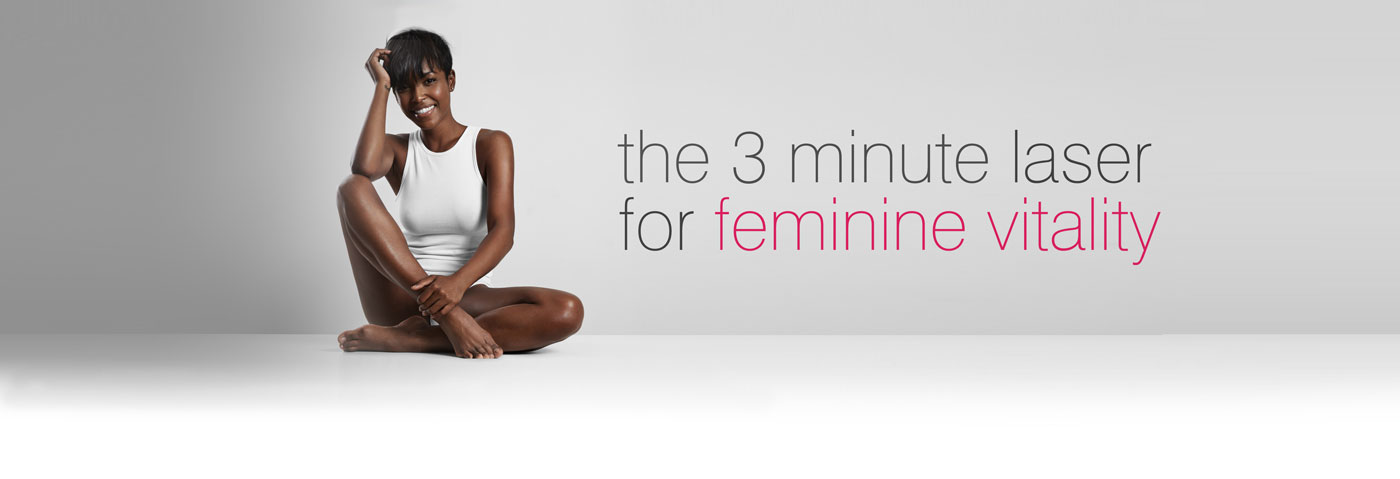
Feel More like Yourself.
diVa™ is a breakthrough laser procedure designed to address a woman’s most intimate challenges. This quick, comfortable, no downtime solution can be customized to meet your unique needs and desired results.

Quick. Comfortable. No Downtime.
diVa™ utilizes the world’s first and only revolutionary Hybrid Fractional Laser (HFL) technology. Every woman is unique and so are her needs. HFL technology allows your clinician to customize your treatments to address your intimate challenges and produce desired results. diVa™ delivers two laser therapies at once for a combined synergistic effect.
The first laser deeply resurfaces the layers of the vaginal wall, replacing it with brand new, healthy tissue. The second laser heats the layers of the tissue where collagen exists.

Does Dr. Coyle Recommend diVa™?
In a Word, yes.
“As a Urogynecologist, I know that vaginal laser therapy changes the lives of so many women. Through my research, I’ve discovered that the diVa™ vaginal laser is the perfect fit. The diVa™ is a far superior laser and I am so thankful that we will be able to offer this therapy to our patients. Just one more way that we here at Coyle Institute are restoring lives through improved pelvic health.”
Michael J. Coyle, DO, FACOOG, FPMRS

Who. What. When.
Who Is an Ideal Candidate?
Women that have had children or are experiencing menopause may be interested in a resurfacing treatment to improve the quality of their vaginal tissue.
What Do Patients Experience?
You may experience a slight pain and pressure against the vaginal wall during the diVa™ treatment, and some patients may experience increased sensitivity near the vaginal opening. diVa™ laser therapy is fast with minimal discomfort.
You may return to your daily routine with minimal to no discharge, spotting, or discomfort; however, you should avoid sexual intercourse for 7-10 days.

diVa® Vaginal Rejuvenation
By Dr. Michael Coyle, D.O.
Hello, everybody. It's Doctor Coyle coming to you live from the Coyle Institute. And today I want to talk about lasers. Actually, I do want to talk a little bit about lasers, I want to talk about the diVa® vaginal laser. And I know there's a lot of buzz stuff going about the vaginal rejuvenation and vaginal lasers and stuff. Well, let's break it down, okay?
First off, let me tell you why I decided to get into lasers in the first place or at least have this to offer for my patients. As a urogynecologist, all day, every day I'm dealing with women that suffer from things that are happening to the vagina or the pelvic region, specifically atrophic vaginitis or painful intercourse.
All we have ever had to help these women out is hormones. Well, unfortunately, a lot of women either can't take hormones or they have been on hormones for years and they just don't work. And so as a urogynecologist, I'm thinking to myself, "All right, well, I need to have something that I can offer these patients." Because, like I said, the hormones, unfortunately, a lot of times don't work.
So I started looking into lasers when they first came out. We've been using lasers to treat skin for over 20 years. And so, doing more research we found out that in 2014 we started offering lasers inside of the vagina. I looked at those lasers and I wasn't quite sold yet. And then 2 years ago the Sciton system came out with the diVa. Once I saw this I was like, "Yes, that makes sense."
So let's break this down and take away a lit bit of the scariness of lasers for a second. So this is the diVa® hand piece. The diVa® laser is actually two lasers firing at one time. Lasers are not to destroy or to blow things up, all right? What this is doing is creating very small wounds or penetration spots into the skin and then the skin then heals those areas. And so you heal new collagen, new blood vessels, new nerve endings, and specifically inside of the vagina you're also creating new epithelium. Epithelium is where you get all your moisture from. And so a lot of these ladies that are struggling with the inability to have intercourse, it's because of vaginal dryness. And so by using a laser like this, we're able to recreate that tissue, regenerate it and get it back to being a much more youthful healthy tissue.
How this works? Like I said, it fires two lasers at the same time. This actually is the hand piece, the probe that goes inside the vagina. One of the beauties of this versus some of the other lasers that are out there is it actually comes with a vaginal probe or vaginal dilator. So instead of the laser actually itself going inside the vagina, this goes over top, it's going to have a little noise here, and now this goes inside the vagina. So that way no part of the laser head actually touches vaginal skin, which is very, very beneficial.
Second is that the piece actually dilates the skin or flattens up the skin and gives us more surface area. The diVa® also is the first automated laser. So what that means is it actually would rotate itself and back itself out. So during the procedure we basically place the laser inside, push the pedal and the laser will rotate 360 degrees and back itself out. Some of the other lasers you actually have to manually turn those. And so as you can tell, it may not be giving you the same efficiency or effectiveness inside the laser. And also by having the two lasers firing at once, one laser goes deeper into the tissue and the other laser goes more superficial. So we're actually treating both layers of the vagina that we need to treat.
The procedure is very simple, you come to the office, you can actually drive yourself here, drive yourself back home. We put in a numbing cream inside of the vagina that sits there for about 10 to 15 minutes. After that, the actual procedure itself only takes about 10 minutes. One of the beauties of having this done by a urogynecologist is the fact that we actually have things that we're trying to correct, like urinary incontinence or mild pelvic prolapse, mild anterior vaginal prolapse like a systocy or a mild rectocele. Obviously, we're also trying to improve painful intercourse and things like that. We've also been very successful in treating scar tissue inside of the vagina, for example, like from in the episiotomy.
So instead of just having, you know, one pass where the laser goes in and comes out, we do more of a focus pass where we're actually trying to focus on exactly why you're here in the first place, okay? So after about 10 minutes the procedure is done. You then are able to drive yourself back home. It is a series of three treatments done one month apart. Very well tolerated, no down time. So, if you're interested, give us a call.
